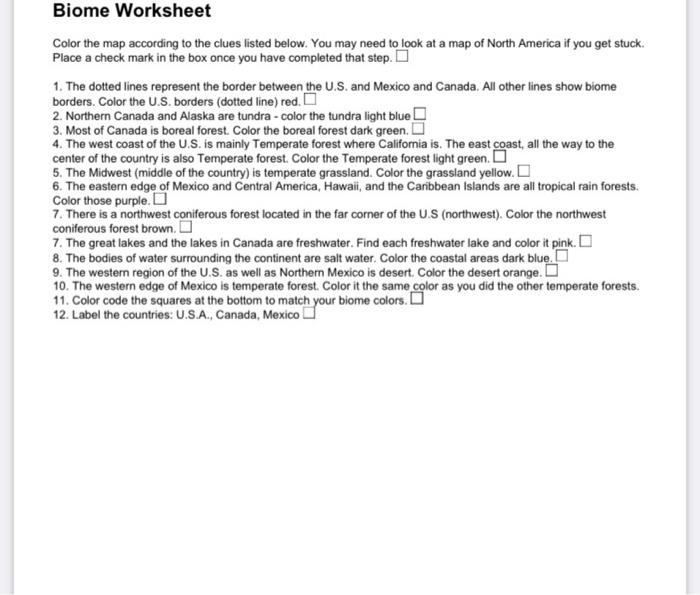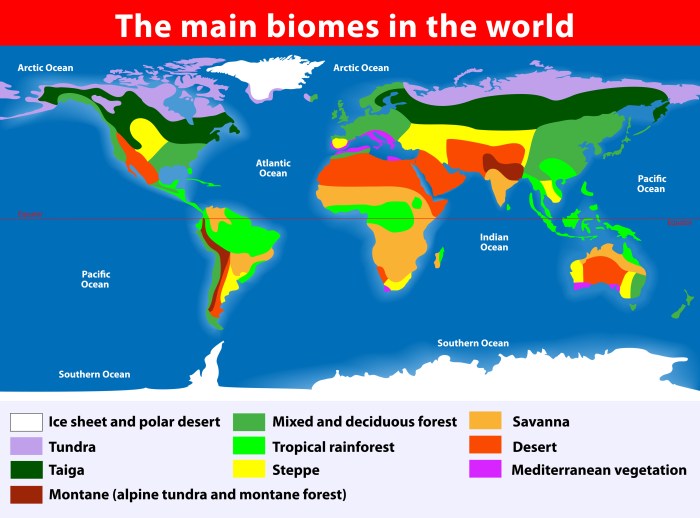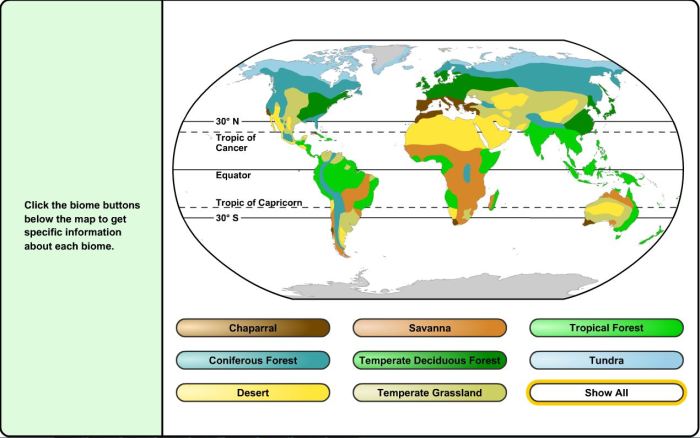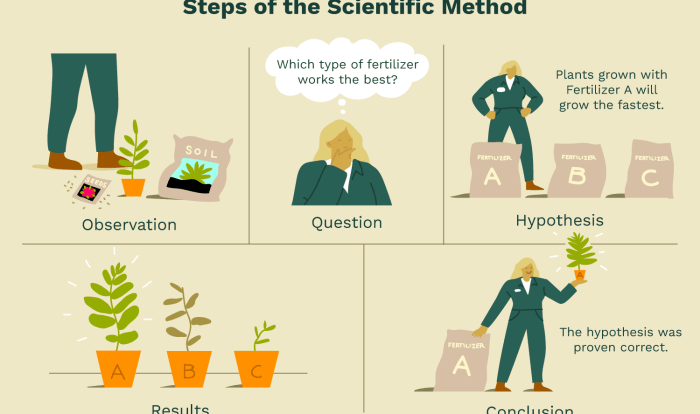Embark on a journey through the diverse ecosystems of North America with our comprehensive Biomes of North America Worksheet Answers PDF. This authoritative resource provides a detailed exploration of the defining characteristics, distribution, and human impact on these vital biomes, empowering you with a deeper understanding of the continent’s intricate ecological tapestry.
Delve into the defining characteristics of each biome, including climate, vegetation, and animal life, presented in an organized table for easy comprehension. Discover the factors that influence biome distribution, such as latitude, altitude, and proximity to water bodies, and explore the ways in which human activities have shaped these ecosystems.
Biomes of North America Worksheet Answers PDF
Biomes of North America are large-scale ecological communities that are characterized by their climate, vegetation, and animal life. North America is home to a wide variety of biomes, from the cold, treeless tundra of the Arctic to the lush, tropical rainforests of Central America.
The following table provides a comprehensive list of biomes found in North America, along with their defining characteristics:
| Biome | Climate | Vegetation | Animal Life |
|---|---|---|---|
| Tundra | Cold, dry, with long, cold winters and short, cool summers | Mosses, lichens, grasses, and shrubs | Caribou, reindeer, musk oxen, arctic foxes, polar bears |
| Boreal Forest | Cold, with long, cold winters and short, warm summers | Coniferous trees (spruce, fir, pine) | Moose, deer, wolves, bears, lynx |
| Temperate Deciduous Forest | Moderate, with warm summers and cold winters | Deciduous trees (oak, maple, beech) | Deer, squirrels, raccoons, opossums, birds |
| Grassland | Temperate, with hot summers and cold winters | Grasses and wildflowers | Bison, pronghorn, coyotes, prairie dogs |
| Desert | Hot and dry, with little rainfall | Cacti, succulents, shrubs | Lizards, snakes, rodents, birds of prey |
| Chaparral | Mediterranean climate, with hot, dry summers and mild, wet winters | Shrubs and small trees | Deer, rabbits, coyotes, bobcats |
| Temperate Rainforest | Mild, with abundant rainfall | Coniferous and broadleaf trees | Deer, elk, bears, wolves, salmon |
| Tropical Rainforest | Warm and humid, with year-round rainfall | Broadleaf trees, vines, and epiphytes | Monkeys, birds, reptiles, amphibians |
Biome Distribution and Factors
The distribution of biomes across North America is influenced by a number of factors, including latitude, altitude, and proximity to water bodies.
Latitude is the most important factor in determining the distribution of biomes. As you move from the equator towards the poles, the climate becomes colder and the amount of sunlight decreases. This results in a change in the types of vegetation and animal life that can survive.
Altitude can also affect the distribution of biomes. As you move up in altitude, the temperature decreases and the amount of rainfall increases. This can create different microclimates that support different types of vegetation and animal life.
Proximity to water bodies can also influence the distribution of biomes. Water bodies can moderate the temperature and humidity of an area, which can make it more hospitable for certain types of vegetation and animal life.
For example, the tundra biome is found in the Arctic region of North America. This biome is characterized by its cold, dry climate and treeless vegetation. The tundra is located at high latitudes, where the climate is too cold for trees to grow.
The temperate rainforest biome is found along the Pacific coast of North America. This biome is characterized by its mild climate and abundant rainfall. The temperate rainforest is located at mid-latitudes, where the climate is mild enough for trees to grow.
The desert biome is found in the southwestern United States. This biome is characterized by its hot, dry climate and sparse vegetation. The desert is located at low latitudes, where the climate is too dry for trees to grow.
Human Impact on Biomes

Human activities have had a significant impact on the biomes of North America. Deforestation, urbanization, and pollution have all contributed to the degradation of these ecosystems.
Deforestation is the clearing of forests for agriculture, development, or other purposes. Deforestation can lead to a loss of biodiversity, soil erosion, and climate change.
Urbanization is the process of converting natural areas into urban areas. Urbanization can lead to a loss of habitat for wildlife, increased pollution, and climate change.
Pollution is the introduction of harmful substances into the environment. Pollution can damage the health of plants and animals, and it can also contribute to climate change.
For example, the temperate deciduous forest biome has been heavily impacted by deforestation. This biome has been cleared for agriculture, development, and other purposes. As a result, the temperate deciduous forest biome has lost much of its biodiversity and is now fragmented into smaller and smaller patches.
The grassland biome has been heavily impacted by urbanization. This biome has been converted into urban areas, which has led to a loss of habitat for wildlife. As a result, the grassland biome is now home to a smaller number of species than it once was.
The desert biome has been heavily impacted by pollution. This biome has been polluted by industrial emissions, agricultural runoff, and other sources. As a result, the desert biome is now home to a smaller number of species than it once was.
Biome Conservation and Restoration

The conservation and restoration of biomes is essential for the health of the planet. Biomes provide a number of important services, including food, water, and shelter. They also help to regulate the climate and protect biodiversity.
Conservation is the protection of biomes from human activities that could damage them. Conservation can be achieved through a variety of means, including land acquisition, zoning, and regulation.
Restoration is the process of repairing damaged biomes. Restoration can be achieved through a variety of means, including reforestation, habitat restoration, and pollution control.
For example, the temperate deciduous forest biome is being conserved through the establishment of national parks and wildlife refuges. These protected areas help to protect the forest from deforestation and other human activities.
The grassland biome is being restored through the use of prescribed burns and grazing management. These practices help to maintain the health of the grassland ecosystem and prevent the spread of invasive species.
The desert biome is being restored through the use of water conservation and pollution control measures. These measures help to protect the desert ecosystem from the impacts of human activities.
Case Studies of Biome Conservation: Biomes Of North America Worksheet Answers Pdf

There are a number of successful biome conservation and restoration projects in North America. These projects have helped to protect and restore some of the most important ecosystems on the continent.
One example of a successful biome conservation project is the Great Smoky Mountains National Park. This park protects a large area of temperate deciduous forest. The park has been successful in protecting the forest from deforestation and other human activities.
Another example of a successful biome restoration project is the Everglades National Park. This park protects a large area of subtropical wetlands. The park has been successful in restoring the wetlands to their natural state. The restoration project has helped to improve the health of the ecosystem and has increased the number of species that live in the park.
Detailed FAQs
What are the major biomes found in North America?
North America is home to a wide range of biomes, including forests, grasslands, deserts, tundra, and aquatic ecosystems.
How do factors like latitude and altitude influence biome distribution?
Latitude affects temperature and sunlight availability, while altitude influences temperature, precipitation, and atmospheric pressure, all of which play a role in determining the distribution of biomes.
What are some examples of human activities that have impacted biomes in North America?
Deforestation, urbanization, pollution, and climate change are among the human activities that have had significant impacts on North American biomes.

